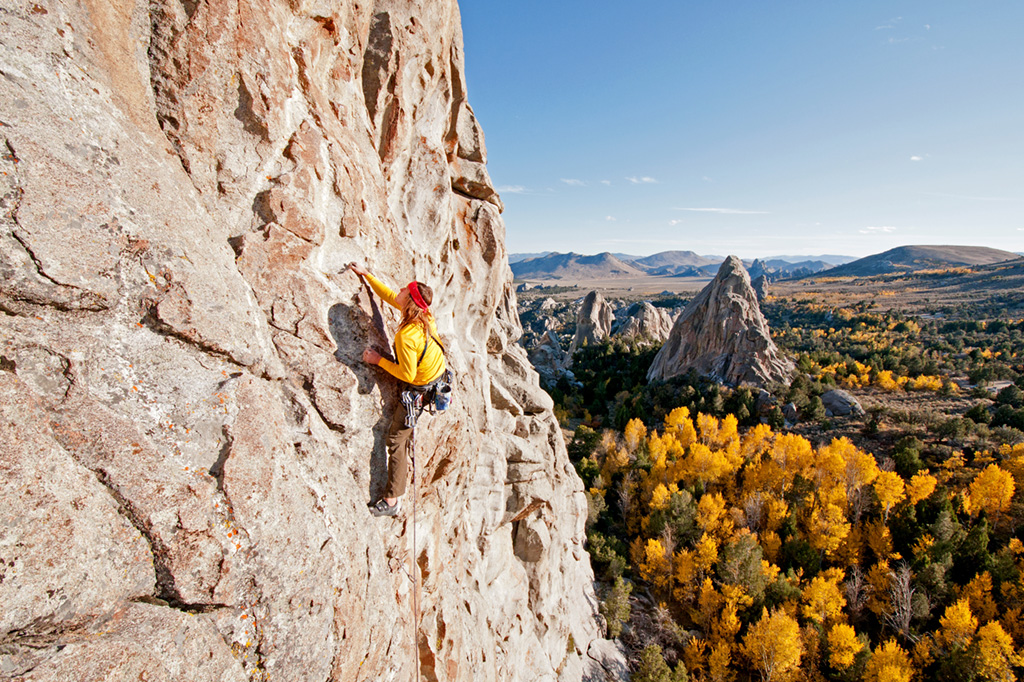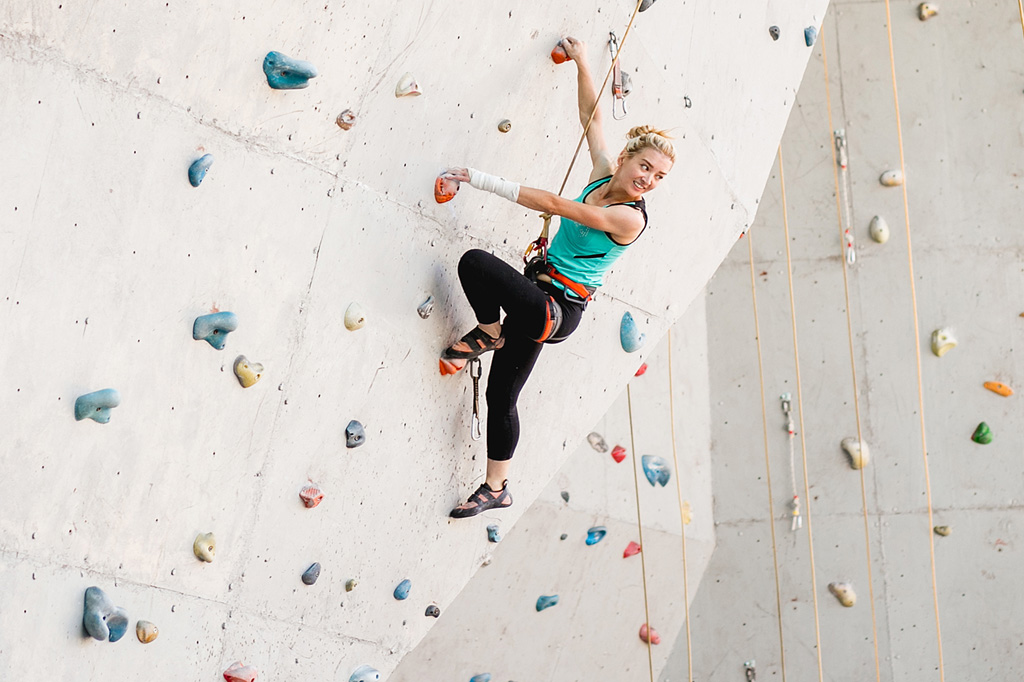It seems Boise has finally made it. Made it past the crux-y part of fostering a sustainable climbing community. The new state-of-the-art climbing gym in Meridian, Vertical View, is the answer. Vertical View started akin to an earthquake; with subtle rumblings that would eventually create something massive. This buzz among climbers has existed for years with comments such as “Somebody needs to build a massive indoor climbing gym around here.”
“It was almost offensive,” Vertical View Operations Manager Tyler Pape said, “that we didn’t have some momentous climbing gym here in Boise.”
Pape is not only a seasoned rock climber but also proficient in long evenings spent sitting at Tyson Gray’s kitchen table, eating Clif Bars and just dreaming—dreaming about the potential that Boise has to birth one of the greatest climbing gyms around. Pape said that Vertical View was originally Tyson Gray’s “brainchild.” Gray, a husband and father of five, says that the idea came to him as his 4-year-old daughter was passing him on a rock wall at another gym. She said, “I’m beating you, Daddy!” In that moment, Gray realized something very different about climbing.
“I love the outdoors and have dabbled in many different activities,” Gray said. “The problem with most of the activities is that we would have to split up as a family. That’s why I love climbing, it’s something we can all do together.”
That “brainchild” is no longer just an idea but a fully-grown 31,000-square-foot building. Vertical View is four stories high with climbing walls varying from 20 to 65 feet high. There are 200 climbing routes, 84 rope anchors, and a route for everyone.
Yes, a route for everyone: new climbers, professional climbers, kid climbers, terrified climbers, and competitive climbers. This is not to mention the I-haven’t-climbed-in-15-years climbers.
“There’s no doubt the wall will be intimidating,” Pape said. “But you’ll walk into Vertical View and see people of all ages climbing and having a really good time—it’s contagious.”
Walking into Vertical View certainly generates that “Wow!” response. The tallest wall actually starts in the basement and towers up to the third floor. When you walk in the front doors, you will see climbers on the wall mid-climb and still going up. The basement, Pape noted, is gigantic. That’s where there’s stadium seating for hosting competitions. Underneath the seating is a 15-foot bouldering cave.
Other areas include an Olympic-certified speed wall, a space designed specifically for kids, and an intense training area for those desiring a challenge. Climbing isn’t the only thing offered at Vertical View. They also have a full fitness gym and two yoga studios: one regular and one hot yoga studio.
Rock climbing is no longer just a recreational activity. It’s also a highly competitive sport. The 2020 Summer Olympics in Tokyo, Japan, will present the first ever sport-climbing competition in the Olympics.
“We want to invite professional climbers to find a home here where they can really push their climbing to the next level,” Pape explained.
Rock climbing is a varied sport with different types of climbing. Bouldering is a short, stout, and powerful type of climbing. The walls stand somewhere between 10 and 15 feet. It requires neither harness nor rope—just your rock-climbing shoes and a chalk bag. Climbers use chalk, similar to the chalk that gymnasts use, to reduce moisture on their hands.
Sport climbing is typically the type of climbing one might imagine. A rope connects the climber to the belayer through a metal anchor that holds the rope up at the top of the wall.
Speed wall climbing is relatively self-explanatory. The climber climbs up the wall as fast as possible using an auto-belay, which is an automatic belaying system that moves with the climber up the wall. When the climber wants to come down, he or she just sits back into the harness and slowly descends.
With so many different types of climbing, it’s easy to understand how Vertical View is filling a gap in the Boise climbing community. Before Vertical View, there was Asana Climbing Gym in Garden City, and Urban Ascent in Boise. Asana Climbing Gym is known as the “bouldering gym” due to its shorter walls. It provides colorful routes with various difficulties amd challenging overhanging sections. It is a favorite of the very committed bouldering community.
Urban Ascent was Boise’s first heartbreak as a climbing community. Urban Ascent was known as the sport climbing gym. They bolstered taller walls with greater sport climbing capabilities. Urban Ascent closed its doors on April 28, 2018. The space was instead used to create affordable housing.
“When we started this conversation five years ago,” Pape said, “we thought Urban Ascent would always be there.”
Pape added that when Urban Ascent closed down, it not only triggered the loss of a climbing gym but also the loss of a lifestyle for the climbers. Climbing, Pape shared, is much more than just an activity. It’s a way of life and a place of belonging. Urban Ascent is gone; however, it is returning under a new name, “The Commons.” The Commons is located in downtown Boise. Its focus areas will be similar to that of Urban Ascent, offering sport climbing, bouldering, a fitness area, and yoga studios.
As Boise sprouts from one climbing gym to three this fall, we notice one very important thing about the climbing community: They’re here, they’re growing, and they’re welcoming you—yes you—with open arms.

Nic Houser climbing a route called She’s the Boss, rated 5.11 and located on Window Rock, City of Rocks. Photo: Mark Weber / Idaho Stock Images.
Outdoor Climbs in Southern Idaho
Often times, climbers will say they “train indoors to climb outdoors.” That’s because climbing indoors is a great place to learn how to use the proper gear to safely take your skills to the real rock. The key information provided below is primarily from longtime Idaho climber Dave Bingham, who is also the author of several guidebooks, including “Idaho Underground” and “City of Rocks & Castle Rocks.”
This fall, he released a second, updated version of “Idaho Underground.” Guidebooks are highly recommended.
The Black Cliffs Boise, Western Idaho
what you’ll find — Towers of columnar basalt that rise up to 65 feet high.
where you’ll find it — Take Highway 84 to Highway 21 on the way to Lucky Peak, the Black Cliffs are on the north side of the river.
why you should go — Easy to access from Boise with mixed climbing routes.
City of Rocks & Castle Rocks Southern Idaho
what you’ll find — A climbing mecca. These granite walls are well known across
the country.
where you’ll find it — Take I-84 east to Delco. Go south on State Highway 77 to Connor Creek Junction and turn right at the stop sign. Highway 77 continues to Almo. City of Rocks and Castle Rocks are both in Almo. There is a wonderful visitor center there where rangers can help you get around.
why you should go — Endless climbing with very good routes, sketchy routes and everything in-between. This is a climber’s true treasure of a place.
The Fins Snake River Plain, Eastern Idaho
what you’ll find — World-class limestone and high-desert sport climbing.
where you’ll find it — Take Highway 33 south from Howe and turn west onto Forest Service Road 557. Keep right on the dirt road and you’ll go through a canyon. Headwall is a campground about 5 miles down the road where you can park. Four-wheel-drive is mandatory.
why you should go — It’s a newly developed area and, well, it’s world-class climbing, so that’s a thing.
Dierkes Lake Twin Falls, South-central Idaho
what you’ll find — Steep, challenging sport climbing and (many) salt-lick-smooth boulders.
where you’ll find it — Take Twin Falls Ave. in Twin Falls approximately 4 miles east. Follow the signs to Shoshone Falls. Dierkes Lake is near Shoshone Falls Park.
why you should go — The climbs, although stout, come with a whole entourage of lakes, waterfalls, and shady spots to picnic.

